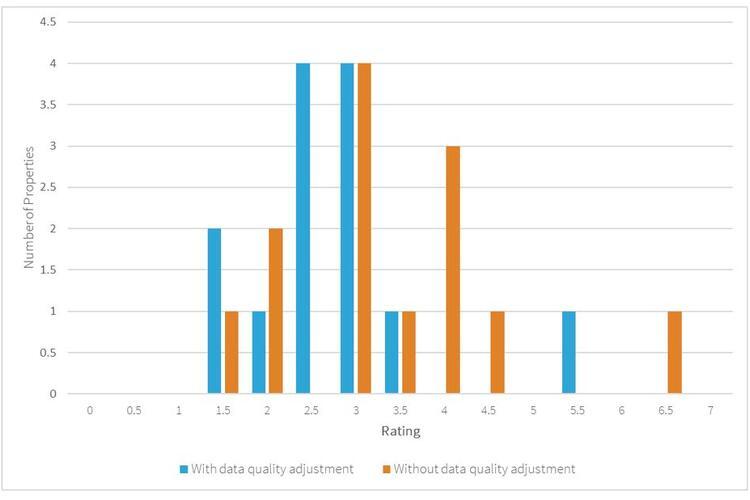The need for operational waste ratings in commercial real estate: piloting the NABERS Waste Rating Tool
01 August 2018Measuring operational performance is critical in order to gain an understanding of what is required to deliver buildings that perform well. This underpins much of our work at the BBP and whilst the importance of energy performance in use is becoming more widely appreciated (see BBP’s work on Design for Performance and REEB), waste performance has yet to attract the same attention.
Over the past two years, driven by increasing public awareness of the issue, we’ve been tackling the issues of waste management with members of the Managing Agents Partnership.
Last year we produced guidance to help the industry improve the accuracy and transparency of waste data through the development of a standardised reporting framework and procurement specifications.
Since that time, we turned our attention to the possibility of developing a tool that rates the operational waste performance of commercial buildings. Members were keen to explore whether such a tool could unlock a more rigorous approach to understanding performance and subsequently drive improvements in waste management practices and performance. This would fill a void so clearly needed in the property industry, by:
- Providing the ability to for buildings to benchmark and compare waste management performance.
- Providing Managing Agents with the ability to build a business case for improvements to propose to property owners.
- Providing service providers clarity on the needs and desires of their clients.
- Incentivising the improvement of waste management performance and services in the UK over time.
By chance, the Office of Environment and Heritage, NSW, who administer the NABERS scheme, where having identical conversations some 2 years earlier and were close to launching their own online NABERS Waste Rating Tool. And, fortunately for us, they were very happy for us pilot the conveniently readymade Australian version and assess its applicability for the UK.
NABERS Waste Rating Tool Pilot
The NABERS Waste Rating Tool was launched in June 2018 and rates the waste management performance of office buildings in Australia via an online interactive platform.
Offices are assessed on the recycling rates achieved, in addition to taking into account data quality and levels of contamination. Ratings are based on 6-star scale with 0 stars being the lowest ratings and 6 stars being the highest possible rating representing a >74% recycling rate.
To assess its applicability for use in the UK, members of the Managing Agents Partnership submitted waste data from 13 properties to be entered into the online assessment tool.
The upload process and ratings assessment were managed by the BBP Executive with the support of Office of Environment and Heritage, NSW, who were hugely helpful in the process.
Encouraging Results
Initial results are encouraging. Properties achieved a ratings range of 1.5 to 5.5 stars with an average of 2.8 stars. These are highlighted by the blue columns in the chart below.
Whilst a small sample size, it demonstrates an appropriate spread in performance. Offices on average achieved a rating that was high enough to encourage participation but low enough to provide room for improvement, with one office demonstrating that a best-in-class rating could be achieved.
Data quality was a challenge, with all ratings being impacted negatively due to the quality of the data submitted. This was predominately as a result in the way in which we collected data and the evidence provided.
However, based on our understanding of going through the process, and learning how the tool treats data, it was identified that the specific data quality issues could be overcome by providing more granular data and additional evidence.
This provides an even more positive picture, as if data quality adjustments were not undertaken offices would have achieved a ratings range of 1.5 to 6.5 stars with an average of 3.4 stars - an average improvement of 0.6 stars per office. These are highlighted by the orange columns in the chart below.
Opportunities Far Outweigh the Challenges
There were many positives to be taken from the pilot.
- Based on the data requirements, there was no reason why such a scheme could not operate in the UK.
- Many of the built-in assumptions relating to waste stream contamination rates and default densities were in-line with our own research and understanding.
- The routes to improve an overall rating encouraged the right kind of behaviours desired by our members, namely:
- Collecting waste data by weight rather than volume
- Increasing levels of on-site segregation
- Undertaking on-site audits
- Improving recycling rates
Of course, it’s not all plain sailing. Significant challenges remain before such a tool could be used in the UK. These are predominately centred around the fact that the tool has been developed for the Australian market.
The basic elements for any rating scheme such a training assessors and administration would need to be worked out, coupled with a clear market demand. Questions remain as to how the tool could also factor in absolute waste generation values, as well as end-destination facility performance into it’s rating methodology.
There were also more nuanced items that would need tweaking to make it more appropriate for the UK, however, none identified are insurmountable.
What Next?
The positive news is that there is a clear desire from our members to have such a tool available in UK, and the Office of Environment and Heritage, NSW are very supportive of our early exploratory work.
We plan to test the tool and the potential for it’s application further over the coming year to understand in detail what requirements would be needed to make available such a scheme to the UK commercial office market.
It’s an exciting time ahead and feels we could be on the cusp of raising the issue of waste up the corporate agenda and filling a clear need within the market – providing a tool that increases transparency over waste data and encourages improvements in performance.
